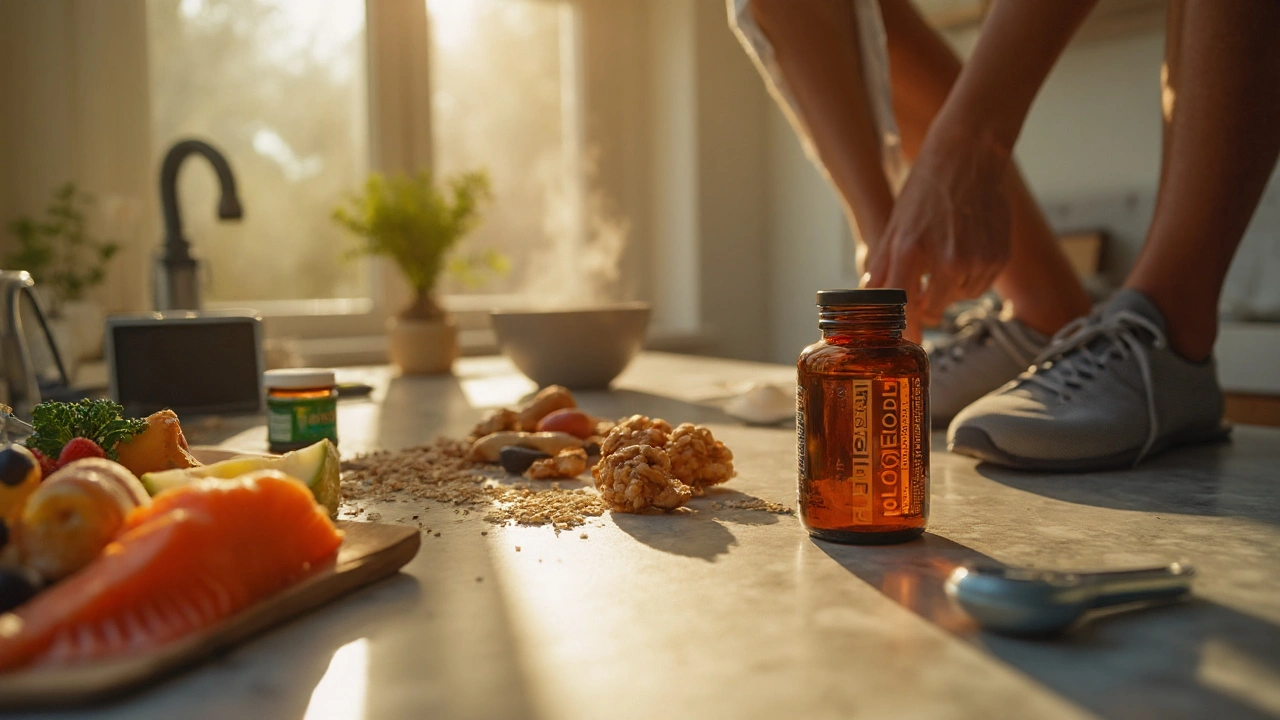Policosanol Benefits for Heart Health: Evidence, Dosage, and Safety

You clicked because you’ve heard whispers: this sugarcane-derived supplement might help your heart-and maybe do more. The honest answer? Policosanol has promise on paper, a mixed record in clinical trials, and a few niche use-cases where it may help. If you want a statin replacement, you’ll be disappointed. If you want a safe adjunct with a clear plan and realistic expectations, you’ll know exactly how to try it (or skip it) by the end.
- TL;DR
- What it is: a blend of long-chain alcohols (mostly octacosanol) from sugarcane wax; also made from beeswax/rice bran. Sold in Australia as a listed complementary medicine.
- Heart impact: independent trials often show little to no LDL lowering; some people see small changes (think 0-5%). Don’t replace statins or ezetimibe.
- Beyond cholesterol: possible mild antiplatelet effects, slight help with walking discomfort in peripheral artery disease, and small improvements in endothelial function-based on small/short trials.
- Who might try it: people with borderline cholesterol who won’t use prescription meds yet; those optimizing lifestyle who want a cautious add-on; statin-intolerant adults already exploring alternatives-after a chat with their GP.
- Safety: usually well tolerated. Avoid if you’re on blood thinners or heading into surgery. Start low (5 mg at night), reassess lipids and symptoms in 8-12 weeks, stop if no benefit.
Policosanol, decoded: what it is and what the research actually shows
Policosanol is a mix of long-chain fatty alcohols extracted from sugarcane wax, with octacosanol as the headline molecule. You’ll also see versions made from beeswax or rice bran. The Cuban sugarcane product kicked off early excitement in the 1990s with bold drops in LDL cholesterol and boosts in HDL. Later trials outside Cuba tried to replicate that and mostly failed to see the same effects.
Mechanistically, policosanol might dampen cholesterol synthesis enzymes, reduce oxidative stress, and ease platelet stickiness. On a lab bench, that looks neat. In real humans, the signal is softer. Large Western guidelines haven’t picked it as a lipid-lowering therapy. The 2018/2019 ACC/AHA and the 2019 ESC/EAS dyslipidaemia guidelines focus on proven agents like statins, ezetimibe, and PCSK9 inhibitors. They don’t recommend policosanol because evidence is inconsistent. Here in Australia, it’s listed by the TGA as a complementary medicine, not an approved cholesterol drug.
So what should you expect? In practical terms:
- LDL cholesterol: in independent trials, effects range from no change to small reductions. For a motivated adult with borderline LDL (say 2.6-3.4 mmol/L), expect little to modest shifts.
- HDL cholesterol: occasional small increases show up in studies, but not reliably.
- Triglycerides: not a consistent effect.
Does that mean it’s useless? Not quite. A supplement doesn’t have to beat statins to be worth considering. Some people-especially those who won’t, can’t, or don’t need prescription therapy yet-try it as part of a broader lifestyle program. The key is to run a clean, time-bound test so you don’t waste months guessing.
What about safety? Across trials, policosanol is usually well tolerated. The most common annoyances are mild: stomach upset, headache, or trouble sleeping in a small fraction of users. Because of possible antiplatelet effects, caution is smart if you’re on aspirin, clopidogrel, warfarin, or DOACs, or if you’re heading into surgery. If you’re pregnant, breastfeeding, or managing a bleeding disorder, skip it and talk to your clinician.
Bottom line on the evidence: you’ll see a mix of positive and neutral studies. High-quality guidelines don’t recommend it for cholesterol lowering. If you use it, do it with realistic goals and clear checkpoints.

Beyond cholesterol: where policosanol may help (and where it won’t)
The title promised hidden benefits, so here’s the candid tour. The non-cholesterol angles are where policosanol gets interesting, even if the data is early or small.
Potential benefits with cautious optimism:
- Platelet stickiness: small human studies suggest policosanol can reduce platelet aggregation. That could matter if your platelets are over-eager. But this is not a replacement for prescribed antiplatelet drugs. Think “gentle nudge,” not “medical therapy.”
- Endothelial function: some short trials report small improvements in flow-mediated dilation, a marker of how well blood vessels respond. If your lifestyle is already firing (dietary fibre, sleep, resistance training), policosanol may add a marginal bump.
- Walking discomfort in peripheral artery disease: limited data hints at improved walking distance in intermittent claudication. If you have PAD, supervised exercise and guideline meds come first; policosanol may be an adjunct only with your specialist’s OK.
Signals that are weak or inconsistent:
- Blood pressure: a few small studies suggest tiny drops (a couple of mm Hg). Your GP won’t swap your ACE inhibitor for this. The effect, if any, is subtle.
- Energy or exercise performance: octacosanol had a moment in sports nutrition decades ago. Quality trials haven’t shown reliable performance boosts.
- Glucose metabolism: no strong evidence that policosanol changes HbA1c or fasting glucose in a meaningful way.
Who might notice something?
- Borderline-risk adults who already eat well, walk most days, and sleep decently. When the big rocks are in place, small add-ons can show up in labs or how you feel.
- People who get bruises on standard-dose aspirin and are working with a clinician to lighten the platelet load. Even then, policosanol is not a like-for-like swap-medical guidance is non-negotiable.
- Statin-intolerant folks exploring a stack of gentler tools. In this scenario, think policosanol alongside plant sterols, viscous fibre (psyllium, beta-glucan), and weight-bearing exercise-each with modest, additive gains.
Who is unlikely to benefit?
- Anyone with high-risk atherosclerotic disease (prior heart attack, stent, stroke). You need proven therapies. Supplements can decorate the cake; they can’t bake it.
- People expecting a 20-30% LDL drop. That’s what statins do. Policosanol isn’t that.
- Anyone unwilling to measure. If you won’t check lipids, blood pressure, or symptoms after a test period, you won’t know if it helped.
To make this practical, use effect-size thinking:
- Dietary fibre (7-10 g/day of viscous fibre): LDL down ~5-10%.
- Plant sterols (2 g/day): LDL down ~7-10%.
- Weight loss of 5-10%: LDL/TG/HDL often improve together.
- Policosanol: expect small or no LDL change; other benefits are possible but modest.
Guideline context you can trust: the 2018/2019 ACC/AHA and 2019 ESC/EAS cholesterol guidelines do not endorse policosanol for lipid lowering. Heart Foundation Australia highlights lifestyle foundations and proven meds; supplements are optional extras with limited roles. That doesn’t ban you from trying-it just sets the bar for expectations.

How to use policosanol safely: dosing, quality, decision tree, and real-world tips
If you’re still curious, here’s a straight, step-by-step way to run a fair trial without wasting time or money.
Dosage and timing
- Start low: 5 mg once daily with the evening meal. Many labels suggest 10-20 mg; start at 5 mg so you can track tolerance.
- Reassess at 4 weeks: if you’re tolerating it and still keen, go to 10 mg nightly.
- Max dose: 20 mg nightly is common in studies. There’s no good reason to go above that.
- Trial window: 8-12 weeks total before you judge.
What to measure
- Lipids: fasting panel at baseline and at 8-12 weeks. Look at LDL-C, non-HDL-C, and triglycerides.
- Blood pressure: home readings, same time daily for 1-2 weeks at baseline and again during the last 2 weeks of your trial.
- Symptoms: if you have intermittent claudication, track pain-free walking time (e.g., treadmill at a fixed speed/incline, distance to symptom).
Decision tree (keep it simple)
- If you’re high risk (past MI, stent, stroke, diabetes with organ damage): talk to your GP/specialist first. Don’t start policosanol to replace proven drugs.
- If you’re moderate risk with elevated LDL: if you’re on a statin, policosanol won’t replace it. You could try it as an add-on only after checking interactions.
- If you’re low risk with borderline LDL and you refuse prescription meds for now: consider a time-bound trial alongside diet, fibre, and consistent exercise.
- At 8-12 weeks: keep it only if you see a meaningful benefit (for example, LDL down by at least 0.2-0.3 mmol/L, better walking tolerance, or improved endothelial measures if you’ve tested them). If not, stop and redirect your effort to proven steps.
Quality checklist (Australia-friendly)
- Source matters: look for sugarcane-derived policosanol. Beeswax versions can differ in composition.
- Label transparency: octacosanol content listed, not just total policosanol. Clear dose per capsule.
- Certificates: ask brands for evidence of independent testing (identity, purity, heavy metals).
- Regulatory status: in Australia, it should carry an AUST L number (listed medicine). That signals it meets TGA baseline quality standards for complementary medicines.
Safety and interactions
- Antiplatelet/anticoagulant drugs: caution with aspirin, clopidogrel, ticagrelor, warfarin, and DOACs. Extra bleeding risk is possible. If you and your doctor decide to proceed, monitor for bruising, nosebleeds, gum bleeding, and prolonged bleeding from cuts.
- Surgery or dental extractions: stop 7-10 days before planned procedures unless your surgeon advises otherwise.
- Pregnancy/breastfeeding: skip it-insufficient safety data.
- Liver disease: check with your clinician first; get baseline labs if you’re adding any lipid-focused supplement.
- Side effects to watch: headache, insomnia, tummy upset, rash. If these show up and persist, stop.
How to stack it (if you do)
- Diet first: Mediterranean-style pattern, 25-30 g fibre daily, with 7-10 g of viscous fibre from oats, barley, legumes, and psyllium.
- Sterols/stanols: 2 g/day in margarine or capsules can move LDL more than policosanol. Combine if you want, but test one variable at a time for 8-12 weeks so you know what helped.
- Exercise: brisk walking 150+ minutes weekly plus two strength sessions. If PAD is on your radar, supervised walking is therapy in its own right.
Mini-FAQ
- Does policosanol actually lower LDL? In many independent trials, the effect is minimal. Some individuals see small drops. Don’t expect statin-like changes.
- Can I take it instead of aspirin? No. A few studies suggest mild antiplatelet effects, but it’s not a clinical substitute for aspirin or other antiplatelet drugs prescribed for you.
- How long until I see changes? If it’s going to help, you’ll usually see something by 8-12 weeks. No change by then? Not worth continuing.
- Is sugarcane better than beeswax policosanol? Most of the positive data uses sugarcane-derived blends. Composition varies by source; stick to transparent, sugarcane-based products if you try it.
- Can I combine it with statins? Often yes, from a tolerance view, but check interactions and watch for bruising or unusual bleeding.
Real-world scenarios and next steps
- Statin-intolerant adult: stabilise diet, fibre, and exercise first. Consider ezetimibe or bempedoic acid with your GP. If you still want a supplement trial, test policosanol for 12 weeks, measure labs, keep only if LDL moves and you feel well.
- Already on aspirin: discuss with your doctor. If approved, start 5 mg nightly, monitor for bruising, and stop 7-10 days before any planned procedure.
- Budget-conscious: put your money into psyllium husk and plant sterols first. If labs improve, you may not need anything else.
- Older adult on warfarin/DOAC: skip policosanol; the bleeding trade-off isn’t worth it.
- Vegans: pick a sugarcane-derived product, not beeswax.
What to do if things go sideways
- New bruising or prolonged bleeding: stop immediately and contact your clinician.
- Headache or insomnia: shift the dose to earlier in the evening or stop if persistent.
- No LDL change: confirm adherence, revisit diet and fibre, then stop policosanol and focus on proven strategies.
- Stomach upset: take with food, reduce the dose to 5 mg, or discontinue.
A quick reality check before you spend: if you expect policosanol to be your cholesterol fix, you’ll be let down. If you view it as a cautious, time-limited add-on to a solid lifestyle plan-and you’re willing to measure, not guess-it can be worth a try. The safe play is simple: get baseline numbers, run an 8-12 week test, keep it only if you see clear, personal benefit.
One last tip from the clinic floor here in Melbourne: set a calendar reminder for your review date the day you open the bottle. Supplements should earn their spot. If this one doesn’t, vote with your wallet and double down on the basics that work every time.
Key phrase to remember: policosanol benefits are modest and individual-measure them, or move on.

One might contemplate the allure of a supplement that promises modest cardioprotective whispers, yet the empirical chorus remains subdued. In the grand tapestry of preventive cardiology, the modest threads of policosanol scarcely alter the pattern when woven alongside diet, exercise, and evidence‑based pharmacotherapy. Emotionally, the yearning for a simple pill reflects a deeper desire to reclaim agency over one's health, a sentiment both understandable and fraught with optimism. Yet, as scholars of the heart, we must temper hope with the measured cadence of data.
Honestly, the policosanol hype is just another nutraceutical buzzword nobody needs.
First, let me correct the grammar: it’s not "policosanol benefits" but "the benefits of policosanol"-a subtle yet telling oversight. This article dances around the data like a conspiratorial cabaret, hinting at hidden miracles while conveniently glossing over the null trials. The colorful language masks the fact that most Western studies have failed to replicate the Cuban hype. One can almost smell the paranoia, as if a secret cabal of supplement manufacturers is pulling the strings. The tone vacillates between pseudo‑science and earnest health advice, creating a cognitive dissonance that feels deliberately engineered. If you’re looking for robust evidence, you won’t find it here-just a patchwork of anecdotal claims. The author’s casual nod to “small improvements” is a classic bait‑and‑switch, luring the unwary into a false sense of efficacy. In short, approach this with the skepticism of a detective interrogating a suspect.
I doubt any supplement beats a proper diet.
Oh honey, the drama of claiming a “hidden miracle” from sugarcane wax is practically theatrical! We’re all waiting for the curtain to rise on the next grand reveal of "miraculous" heart benefits, but the stage is empty. The author flirts with hope like a soap‑opera star, while the lab results are as bland as unsalted oatmeal. If you wanted fireworks, you’d need more than a sprinkle of octacosanol – you’d need actual evidence. So let’s keep the spotlight on proven meds and not let the hype steal the show.
One must appreciate the erudite tone of this piece, though it suffers from occasional typographical errors that undermine its gravitas. The author posits that policosanol may offer modest cardiologic benefits, yet fails to provid a rigorous meta‑analysis to substantiate such claims, making the argument feel rather half‑baked. Moreover, the usage of the term "benefits" without quantifiable metrics renders the discourse vague and imprecise. In sum, while the prose aspires to highbrow scholarship, the execution falls short, leaving the reader yearning for more concrete data.
Think of this supplement as a gentle coach beside your daily routine-nothing dramatic, just a modest nudge. If you already walk, eat fibre, and manage stress, a low‑dose trial can be a mindful experiment. Track your labs, and if the numbers shift even slightly, celebrate the small win. Otherwise, refocus on the fundamentals that consistently move the needle.
Hey there! I love the enthusiasm for trying something new, and it’s great that you’re thinking about measuring outcomes. Start with the 5 mg night dose as the article suggests, keep an eye on any side effects, and set a calendar reminder for the 12‑week check‑in. If you feel better or see a tiny improvement in your numbers, keep it going; if not, no shame in switching focus back to the basics. You’ve got this – stay curious and stay consistent!
Let’s break down the practical takeaways for anyone considering a policosanol trial, step by step. First, understand the baseline: obtain a fasting lipid panel, blood pressure readings, and note any symptoms such as intermittent claudication. Second, choose a reputable product – preferably sugarcane‑derived with clear octacosanol content and an AUST L number to ensure TGA‑listed quality. Third, start low at 5 mg nightly with food to minimise gastrointestinal upset, and record any side effects in a simple log.
After four weeks, if tolerability is good, you may increase to 10 mg and continue the log. By week eight, repeat the fasting lipid panel and blood pressure measurements under the same conditions as the baseline. Compare the LDL‑C, non‑HDL‑C, and triglyceride values – a modest reduction of 0.2–0.3 mmol/L might be considered a positive signal, though not clinically transformative.
Importantly, watch for bleeding risk. If you’re on aspirin, clopidogrel, warfarin, or a DOAC, discuss with your clinician before initiating, as policosanol’s antiplatelet activity could augment bleeding propensity. Also, stop the supplement 7–10 days prior to any surgical or dental procedures to avoid excess bleeding.
For those with peripheral artery disease, you can incorporate a simple walking test: measure the distance covered before the onset of pain, both at baseline and after the 12‑week trial. A small improvement in pain‑free walking distance could indicate a functional benefit, even if lipid changes are minimal.
Safety-wise, the most common adverse events are mild – occasional headache, transient insomnia, or mild stomach upset. Should any of these persist beyond a week, consider reducing the dose back to 5 mg or discontinuing entirely.
Remember, the evidence for policosanol is modest at best. It should never replace statins, ezetimibe, or PCSK9 inhibitors in high‑risk patients. Think of it as an adjunct, akin to adding a dash of spice to an already well‑seasoned dish. Use it only if you have a clear, time‑bound goal, and cease use if you do not see a measurable benefit.
Finally, keep the experiment transparent: set a reminder on your phone for the 12‑week reassessment, document the numbers, and share the results with your healthcare provider. This disciplined approach ensures you’re not just guessing but making evidence‑based decisions about your heart health.